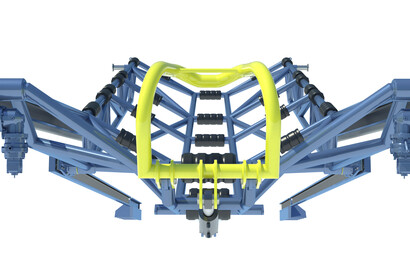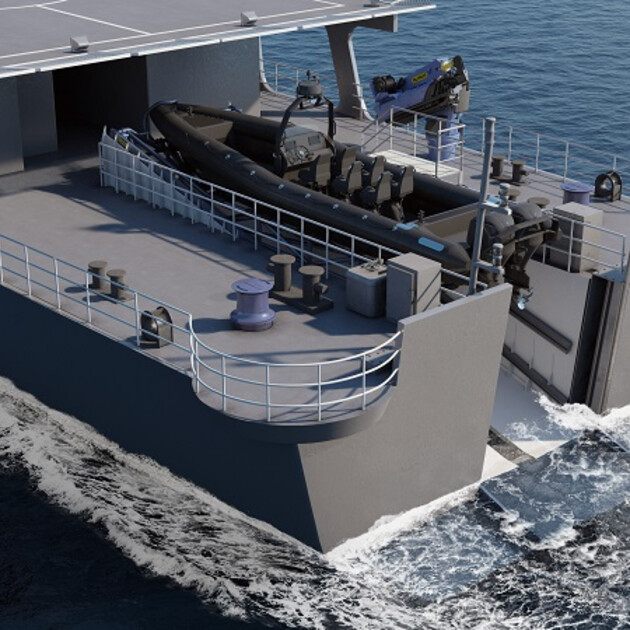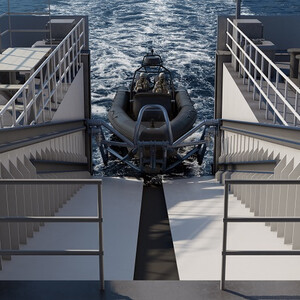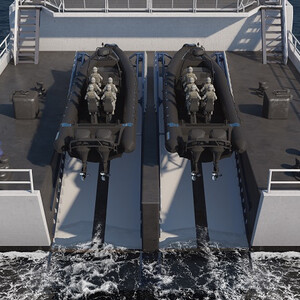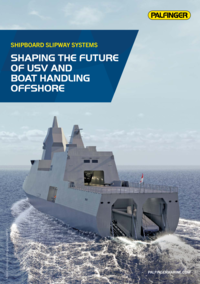
Model PSEC
- SWL: Up to 5 metric tonnes
- Boat cradle: Tubular steel frame with fenders and passive rollers
- Slipway operation: Semi-automatic with single-operator
- Cradle shape and dimensions: Designed to purpose and boat(s)
- Slipway angle: Up to 15° slope angle
- Slipway access/entrance: Via submerged slipway cradle
- Boat guiding system: Cradle shape incl. fenders, rollers and bow clamp
- Cradle suspension: Load bearing travelling rail
- Cradle movement (In/Out): Hydraulic operated rack and pinion drive
- Cradle elevation (Up/Down): By asymmetrical guide rail system
- Boat securing mechanism: Hydraulic operated bow clamp
- Recovery of boat: Boat thrusting against cradle while cradle is retracted
- Recovery method: Gradual transfer of boats weight from water to cradle
- Remote control from daughter craft
- Various remote control options on vessel side
- Power and control system redundancy
- Emergency launch and recovery by accumulator and UPS
- Parking position for additional boat(s)
- Higher slope angle and/or SWL (if possible/feasible)
Slipway and stern entry systems with boat cradle
PALFINGER's boat cradle is an open and light tubular steel design, which minimizes forces induced by waves and currents. The boat cradle is supported by mechanical load bearing support/drive rails and wheel/bearing arrangements on both sides of the boat cradle structure.
The inside of the boat cradle is fitted with fenders to protect and guide the water craft during launch and recovery. A weaklink mechanism protects the boat cradle against higher forces than it is designed to withstand. The “bow section” of the boat cradle is fitted with an automatic mechanical securing clamp. The clamp is hydraulic operated and equipped with a quick-lock function.
The stern end of the boat cradle is designed for easy and safe access during launch and recovery and to avoid any conflicts with daughter craft’s drive system. The system is also well suited for handling of crafts with multiple outboard engines or stern drives.
BOAT CRADLE DRIVE SYSTEM
Rails on each side of the boat cradle serve as guide and support mechanisms for the boat cradle while it is travelling up and down the slipway slope. One of the guide rails on each side of the slipway slope is fitted with a tooth rack for the drive system.
Longitudinal movements and heave/lowering of the boat cradle is done by hydraulic powered pinion drives mounted on each side of the boat cradle. The hydraulic pinion drive motors are fitted with automatic overrunning clutches, allowing residual energy from the water-craft to be transferred into forward motion of the boat cradle in case the water-craft is approaching the boat cradle with excess speed.
BOAT CRADLE ELEVATOR
Vertical movements are driven by the two mechanical support and guide rails on each side of the boat cradle. The mechanical support and guide rails (located on the stern of the vessel) guide the boat cradle to the horizontal parking position when the boat cradle is retracted by the rack and pinion drive system.
MAX. SEA STATE FOR SLIPWAY OPERATIONS
Test and operational use of this Slipway System have been performed in Sea States 3 with mother vessel steaming ahead with low speed.
Safe operations at higher Sea States may be possible but is highly dependent on:
- Stern entry arrangement
- Mother vessel heading and speed
- Mother vessel responsiveness (RAO Profile)
- Waves and wind pattern
- Boat driver’s skills

